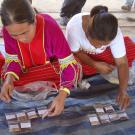This 6-page manual explains how to build a seed germination cabinet in detail, by Abram J. Bicksler, with the International Sustainable Development Studies Institute in Thailand.
Introduction:
Saving your own seeds is a cost-effective way to access crop seed for future planting and to help maintain the planet’s plant biodiversity. Whether you plant your own saved seeds, give them away to friends and neighbors, or distribute them through your organization, knowing the viability of your seeds is important.
What is seed viability? Seed viability is a measure of the percentage of seeds that will germinate after storage. The greater the viability of your seeds, the fewer seeds will be needed to establish a desired number of plants in the field or nursery.
Many easy ways exist to test seed viability. A seed germination test is probably the most simple: seeds are given the needed resources (air, water, warmth, and light) to germinate and grow into a seedling. Simply place seeds in the soil or in a pot of soil and see how many grow. However, the problem with using soil, pots, and outdoor resources is that environmental fluctuation exists. This can cast doubt on the true viability of the seeds (did the seeds fail to germinate because they were dead, or because they were watered erratically, fell victim to fungal attack, got too hot, etc.?).
Lower-than-optimum temperatures for germinating certain types of seeds often occur at the ECHO Asia Seed Bank in northern Thailand during the cold season. Outside nighttime temperatures often dip to 13ºC (55ºF) or lower, and afternoon temperatures rarely rise above 29ºC (85ºF). With cool temperatures complicating certain seed germination trials, the seed bank staff decided that a better way to conduct a seed germination test and reduce uncontrolled variance (forces like irregular watering, fungal spores, temperature fluctuations, etc.) would be to create a dedicated seed
germination cabinet where these factors of variance can be moderated.
The seed germination cabinet is now routinely used to test seed viability, and has provided encouraging results. You too can build a low-cost seed germination cabinet to improve seed germination results and to boost your knowledge about the viability of your seed stocks.
Instructions for how to build the cabinet and test seed viability
The manual includes instructions for how to build a low-cost seed germination cabinet to improve seed germination results and to boost farmer knowledge about the viability of seed stocks. It also includes basics of seed germination testing, a budget, and helpful images and diagrams. This manual is associated with the Horticulture Innovation Lab project "Strengthening indigenous seed systems: Bangladesh, Cambodia, Laos, Thailand, Vietnam."
How to build a seed germination cabinet for testing seed viability

